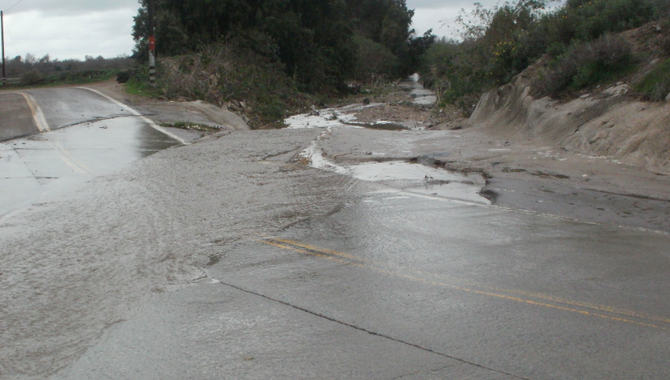 Facebook
Facebook
 X
X
 Instagram
Instagram
 TikTok
TikTok
 Youtube
Youtube

San Diego city crews have begun dredging two congested river channels in the Tijuana River Valley, and ranchers, horse owners, and residents of the area, which is prone to severe flooding, say they are glad to see it.
John Gabaldon, president of the Tijuana River Valley Equestrian Association, has waited two years for the dredging to start. Last year, a lawsuit against the city blocked the dredging.
"Horse owners and businesses in the valley are relieved — every rainstorm no longer has the potential to wreck our lives," Gabaldon said.
Crews have begun dredging a channel that begins in Smuggler’s Gulch and runs north about 5/8 of a mile to connect to the river's south channel. They will also dredge the pilot channel, which splits from the main channel and runs parallel, starting about 100 feet east of Hollister Street and ending about a mile west of the bridge, where it reconnects with the main river channel.
The Smuggler’s Gulch channel crosses Monument Road and often floods it during minor rains. In a September 2012 report, the city estimated that it was operating at about 73 percent of its capacity because of sediment buildup. The river’s pilot channel that runs under the Hollister Street Bridge is so obstructed with sediment and vegetation that city stormwater experts estimate it can barely handle 5 percent of what it was designed for.
According to the city report, it can handle about 10 cubic feet per second; a two-year rain event — just a little more than a normal year — generates a flow of 278 cubic feet per second. That's another way of saying it will flood.
Last year, a lawsuit filed by San Diegans for Open Government (represented by attorney Cory Briggs) blocked the planned dredging after a judge found the group had a good argument that the city hadn't followed its own environmental rules. Resident ranchers, including Dick Tynan, spent an anxious winter watching the rain.
"We got lucky last year," Tynan said. "Four inches of rain and we're flooded. The city knew they would have to do the maintenance when they changed the flow of the river ten years ago and left us with this problem. Now, we've spent a lot of time worrying and it's just the lack of maintenance."
Two years ago, the dredging operation next door to his ranch provided some amusement as well as flood relief, Tynan said.
"They buried a D6 [Caterpillar bulldozer] by driving it onto the wet sand, and they had to chain it to some dump trucks to tow it out," Tynan remembers. "They had to bring in a 'Swamp Cat,' about 20,000 pounds lighter, with tread to work on that area."


San Diego city crews have begun dredging two congested river channels in the Tijuana River Valley, and ranchers, horse owners, and residents of the area, which is prone to severe flooding, say they are glad to see it.
John Gabaldon, president of the Tijuana River Valley Equestrian Association, has waited two years for the dredging to start. Last year, a lawsuit against the city blocked the dredging.
"Horse owners and businesses in the valley are relieved — every rainstorm no longer has the potential to wreck our lives," Gabaldon said.
Crews have begun dredging a channel that begins in Smuggler’s Gulch and runs north about 5/8 of a mile to connect to the river's south channel. They will also dredge the pilot channel, which splits from the main channel and runs parallel, starting about 100 feet east of Hollister Street and ending about a mile west of the bridge, where it reconnects with the main river channel.
The Smuggler’s Gulch channel crosses Monument Road and often floods it during minor rains. In a September 2012 report, the city estimated that it was operating at about 73 percent of its capacity because of sediment buildup. The river’s pilot channel that runs under the Hollister Street Bridge is so obstructed with sediment and vegetation that city stormwater experts estimate it can barely handle 5 percent of what it was designed for.
According to the city report, it can handle about 10 cubic feet per second; a two-year rain event — just a little more than a normal year — generates a flow of 278 cubic feet per second. That's another way of saying it will flood.
Last year, a lawsuit filed by San Diegans for Open Government (represented by attorney Cory Briggs) blocked the planned dredging after a judge found the group had a good argument that the city hadn't followed its own environmental rules. Resident ranchers, including Dick Tynan, spent an anxious winter watching the rain.
"We got lucky last year," Tynan said. "Four inches of rain and we're flooded. The city knew they would have to do the maintenance when they changed the flow of the river ten years ago and left us with this problem. Now, we've spent a lot of time worrying and it's just the lack of maintenance."
Two years ago, the dredging operation next door to his ranch provided some amusement as well as flood relief, Tynan said.
"They buried a D6 [Caterpillar bulldozer] by driving it onto the wet sand, and they had to chain it to some dump trucks to tow it out," Tynan remembers. "They had to bring in a 'Swamp Cat,' about 20,000 pounds lighter, with tread to work on that area."